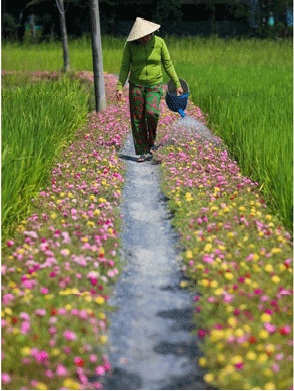Ho Chi Minh City authorities and residents have put efforts into converting waste hotspots into flower roads.

Blooming flowers in a road in Binh Chanh District which used to be garbage dump (Photo: SGGP)
An urban renewal campaign with the title “HCMC dwellers do not litter on streets and canals for a clean city” has been launched as per the city Party Committee’s Direction 19.
Authorities in districts across the city simultaneously carried out urban renewal, dredging canals and rivers with focus on eliminating hotspots and polluted waste.
Thanks to local governments and residents’ efforts, flowers are also blooming on roads which used to be sites for the disposal of waste materials.
Specifically, administration in Binh Chanh District launched activities in response to the direction to erase waste hotspots. Many roads in the district were places where people throw garbage and weeds on both sides; yet now, blooming flowers beautify the whole area. Flowers have been grown along paths into houses and rice fields. Flowers in bloom blending with green field make the area beautiful. This attracts more passer-by’s attention.
Resident Le Thi Thanh in Quy Duc Commune in Binh Chanh District shared that she planted the flowers to create beautiful scenery around her house and to prevent passers-by from littering on the road. When the flowers bloomed, some people dropped by to take photos in her flower garden and even asked for seedlings to grow the flowers.
Flowers are grown in roads which used to be garbage sites in Hoc Mon outlying district, locals are so happy with the change that they pledged to join hands in preserving the beautiful green flower streets.
Similarly, during the two months of conducting the campaign, veterans of Binh Tan District turned the landfill on the riverbank along Bo Song Street in Tan Tao A ward into flower beds, yellow bellflowers, and green ornamental plants with an area of about 1,500 square meters. Binh Tan installed hundreds of trash bins in parks as well as public places.
According to the assessment of the Department of Natural Resources and Environment of Ho Chi Minh City, models of community-based environmental protection have achieved great results. Many single community-based models carried out with assistance of unions have so far been successes; therefore, these community-based models have been expanded.
Environmental protection pilot projects contribute significantly to raising people’s awareness and changing people’s behaviors in a positive way. Meantime, it will increase the leadership responsibilities of local authorities in residential areas.
According to Ms. Nguyen Thi Thanh My, Deputy Director of the Department of Natural Resources and Environment of Ho Chi Minh City, the models of the community-based environmental protection will encourage people to voluntarily participate in environmental protection activities and thereby enhance the standard of living.
By Minh Hai – Translated by Anh Quan